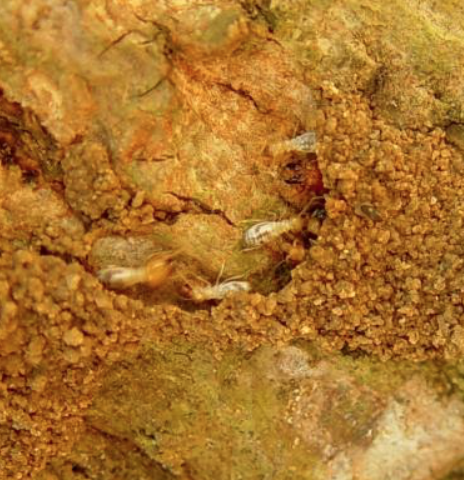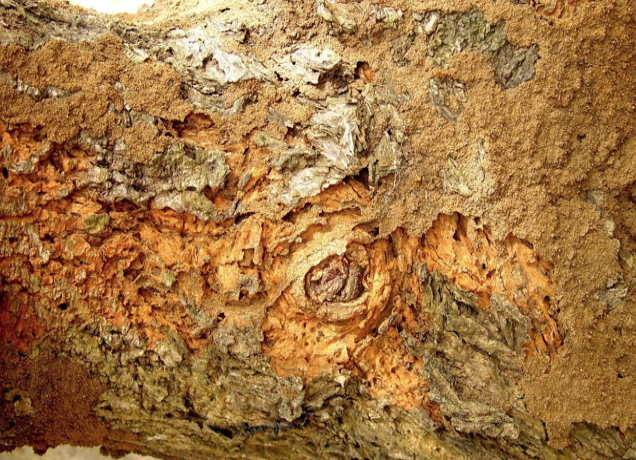Bark eating termites
Credit: Biovision-Infonet

(c) A. M. Varela, icipe

(c) A. M. Varela, icipe

(c) A. M. Varela, icipe
They are generally associated with old mango trees. They may damage branches and other parts by tunnelling the wood, but usually are not of economic importance. Sickly, injured plants are more likely to be damaged than healthy, vigorous plants.What to do:
- Provide good growing conditions for the trees. Termites more often attack sickly or water stressed plants than healthy plants.
- Avoid unnecessary injury to the plants as this may facilitate entry of termites.
- Conserve natural enemies.
- Inspect trees, especially pruned trees, for termites attack. Remove affected plant and kill the termites, they are normally found inside the hollowed parts.
Maize eating Termites
Termites (Microtermes spp., Macrotermes spp., Allodontermes spp., and Odontotermes spp)
Often referred to as “white ants”, they occasionally cause partial or total defoliation of maize seedlings, but are mainly damaging to older maize plants. Severely damaged plants may lodge and be completely destroyed by termites. The longer a field has been cultivated, the greater will be the yield losses caused by termites. Their feeding inside the stems causes the plant to wither and sometimes die. Termites begin to attack the roots and stems about 3 months after planting, and eventually cover them with tunnels built of soil. As plants mature the amount of damage increases rapidly. Infestation is particularly serious in dry season. It has been established that termites can damage up to 25% of maize crops in Malawi (WISARD Project Information, 2001).
What to do:
- Promote conditions for healthy plant growing to prevent termite damage.
- Plough field to destroy the termites’ nest, runways, and tunnels and to expose them to predators, such as ants, birds, chicken, etc.
- Practise crop rotation to reduce the build-up of termites.
- Remove plant residues and other debris especially moist and decaying woods.
- Harvest at the right time, as termites often attack maize left in the field after maturity. Attacked stalks may fall down and the termites may attack the cobs and panicles.
- Where there is risk of termite infestation, avoid leaving the crop in the field after harvest on stooks, stacks or windrows.
Termites and Coffee
Termites can be a serious problem for coconut palms, particularly for young trees in tree nurseries or trees that have just been transplanted into the field. Termites live in the soil in hills, construct tunnel from the hills to the palms and feed on all parts of young coconut palms. Damage occurs mainly during the dry season.
Many plants have a repellent or even insecticidal effect on termites and can be applied as spray directly against termites or as barrier around the trunk of coconut palms:
- Neem: seeds and leaves (extracts or cake)
- Quassia indica or Q. amara: bark and leaves
- Sandalwood: wood
- Chinaberry, persian lilac (Melia azedarach): bark, branches, leaves, extracts
- Euphorbia sp.: “In Tanzania, especially in Dar es Salaam and coast regions, farmers plant with each seedling 2 or 3 sticks of Euphorbiasp. to protect the young palms from termite attack. On nurseries the Euphorbia plants can be planted around the seedbed to prevent access of termites to the palm seedlings and young palms. When the palms have grown big the euphorbia is simply cut down. The practice is widespread and farmers are convinced that it really does keep termites off the susceptible seedlings ( Z. Seguni, MARI personal communication)”.
What to do:
- Plant early with the rains.
- Avoid planting on very dry land or on termite mounds.